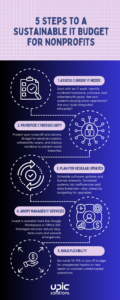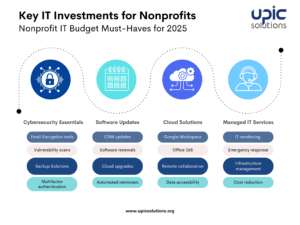How Can Nonprofits Effectively Integrate Technology Without Overspending?
Nonprofits often find themselves in a delicate balance: driving their mission forward while working within constrained budgets. However, as technology becomes a more critical part of nonprofit operations—helping with everything from donor management to data security—investing in IT infrastructure is no longer optional. For over 23 years, Upic Solutions has worked alongside nonprofits, and we’ve seen firsthand the challenges many organizations face when budgeting for IT. Here, we’ll guide you through how to create a sustainable IT budget that ensures cybersecurity, operational efficiency, and scalability: without overspending.
Assess Current IT Needs and Priorities

Before you can build an IT budget, you need to assess where your nonprofit stands in terms of technology. Start by evaluating the current state of your hardware, software, cybersecurity, and IT services. Over the years, we’ve heard nonprofit leaders express frustration when unexpected tech failures disrupt operations or when an outdated CRM limits their fundraising efforts.
Common Questions to Ask:
- Are your computers and servers outdated, slowing down daily tasks?
- Do you have any gaps in your cybersecurity measures?
- Is your nonprofit using donor management software that’s not integrated with your email marketing or accounting systems?
By performing an audit of your IT infrastructure, you can identify where immediate upgrades are necessary versus what can be planned for in future years. According to a 2024 Tech Trends report for nonprofits, many organizations waste time and money by failing to assess their IT needs and prioritizing the wrong technology investments.
Incorporating Cybersecurity into the Budget
In today’s digital world, nonprofits are increasingly being targeted by cybercriminals. A study by IBM’s 2023 Cybersecurity Report revealed that 6 out of 10 nonprofits have experienced a cyberattack, with the average breach costing over $4 million Protecting sensitive donor data is not just a legal and ethical responsibility: it’s vital for maintaining trust with your stakeholders.
When planning your IT budget, prioritize investments in:
- Email filtering and encryption to protect against phishing.
- Vulnerability scanning to identify weaknesses in your system.
- Backup and disaster recovery solutions, like the enhanced Office 365 backups we offer at Upic, which ensure business continuity in case of ransomware attacks.
These are foundational elements of cybersecurity and should be treated as non-negotiable in your budget.
Planning for Regular Software Updates and Licenses
Software evolves rapidly, and falling behind on updates can lead to inefficiencies, security vulnerabilities, and decreased productivity. Budgeting for annual software updates, such as those related to your CRM, accounting systems, or cloud platforms, should be factored into your IT spending. Many nonprofits struggle here—often trying to save costs by skipping upgrades, which can result in compatibility issues or even a data breach down the road.
A Nonprofit Pro study in 2023 showed that organizations investing in regular software updates saw a 20% increase in overall efficiency and a 25% reduction in downtime. Incorporating automated reminders and renewal dates for software licenses into your budget planning is a small step that can prevent major operational disruptions.
Allocating for Cloud and Managed IT Services
Cloud services have revolutionized how nonprofits manage their data and collaborate remotely. Platforms like Google Workspace and Microsoft Office 365 are not just cost-effective but also scalable, allowing your IT solutions to grow alongside your organization. Managed IT services can also help nonprofits save on in-house IT staff costs, while still offering access to cybersecurity experts and IT infrastructure management.
At Upic, we often see nonprofits hesitate to invest in managed services due to upfront costs, but studies show that outsourcing IT management leads to lower long-term costs and fewer emergencies. A 2024 Forbes report suggests that managed IT services reduce technology-related downtime by 35%

Building Flexibility and Contingency into the Budget
Tech issues don’t always arise at convenient times. That’s why building flexibility into your budget is crucial. We recommend nonprofits reserve 10-15% of their IT budget for unexpected repairs or new tech needs that may emerge during the year. This ensures you’re not scrambling for resources when issues arise, and your operations can continue without major interruptions.
Creating a Multi-Year IT Plan
It’s important to think long-term when developing an IT budget. Create a multi-year plan that accounts for phased technology investments, such as upgrading hardware every three years or gradually implementing a new CRM system over two fiscal periods. This helps to spread out larger expenses while ensuring your nonprofit stays technologically up to date.
Conclusion: Sharing Our Knowledge on Nonprofit IT Budgeting Success
Reflecting on over 23 years of collaboration with nonprofits, we’ve witnessed the transformative power of sustainable and scalable IT infrastructures. By addressing challenges such as limited resources and evolving cyber threats, we’ve enabled organizations to focus on their core mission. Our services encompass protection against phishing, ransomware, and data breaches, continuous monitoring, secure Office 365 backups, helpdesk support, security awareness training, workstation management, email support, and much more! Ensuring your team operates efficiently and securely.
We understand the unique hurdles nonprofits face and are committed to providing expert guidance. If you’re seeking assistance in assessing your IT needs and developing a budget that balances security, efficiency, and sustainability, consider reaching out for a free consultation. Together, we can help your nonprofit thrive. To schedule your free consultation, please email us at answercenter@upicsolutions.org.
